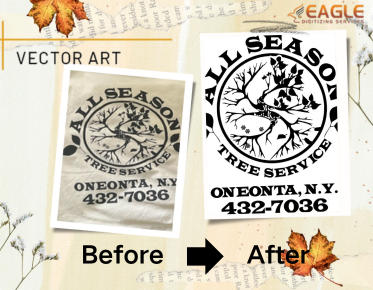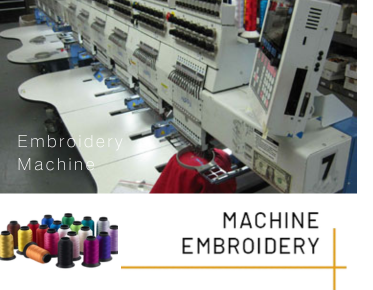Can You Use a 3D Printer to Print Directly on a Silk Screen from Eagle Digitizng?
3D printing technology has revolutionized numerous industries, bringing innovation and customization to new heights. This fascinating method allows for the creation of three-dimensional objects from digital designs, layer by layer. But what about silk screen printing? This venerable technique has been a staple in the art and commercial sectors for decades. Combining these two technologies could open up a world of possibilities. But is it really feasible to print directly on a silk screen using a 3D printer? Let's delve into the intricacies of these processes and explore their potential intersection. If this post spurred your interest and you want to find out more about vector art services in usa, please feel free to contact us.
What is Silk Screen Printing?
Basic Process and Techniques
The process involves creating a stencil (or screen) and using it to apply layers of ink on the printing surface. The screen is made of a mesh, originally silk but now more commonly polyester stretched over a frame. The non-printing areas are masked off, and ink is forced through the mesh openings using a squeegee. Each color requires a separate screen, and the layers build up to create the final image.
Common Uses and Applications
Silk screen printing is versatile, and used in industries ranging from fashion to electronics. It’s prized for its durability and vibrant colors, making it ideal for everything from t-shirts and posters to circuit boards and decals. Artists also appreciate the tactile quality it imparts to prints, often experimenting with textures and effects that other printing methods cannot achieve.
The Basics of 3D Printing
How 3D Printing Works
3D printing, often known as additive manufacturing, is the process of layering objects together from digital models. The process begins with a digital 3D design, which is sliced into thin horizontal layers. The 3D printer then deposits material, typically plastic or resin, layer by layer to create the object. This method allows for complex geometries and highly customized designs that traditional manufacturing cannot easily produce.
Different Types of 3D Printers
Several types of 3D printers exist, each suited to different applications:
● Fused Deposition Modeling (FDM): The most common type uses thermoplastic filaments melted and extruded through a nozzle.
● Stereolithography (SLA): Utilizes a laser to cure liquid resin into solid objects, offering high precision.
● Selective Laser Sintering (SLS): Uses a laser to sinter powdered material, creating strong and complex parts.
● Digital Light Processing (DLP): Similar to SLA but uses a digital light projector to cure resin.
Common Materials Used in 3D Printing
Materials vary widely depending on the printer type and application:
● PLA (Polylactic Acid): A biodegradable thermoplastic derived from renewable resources, popular for its ease of use.
● ABS (Acrylonitrile Butadiene Styrene): Known for its strength and durability, commonly used in industrial applications.
● Resins: Used in SLA and DLP printers, offering high detail and smooth finishes.
● Metals and Ceramics: Utilized in advanced applications, including aerospace and medical implants.
The Intersection of 3D Printing and Silk Screening
Potential Benefits of Combining Technologies
Merging 3D printing with silk screening could revolutionize the production process. Imagine the ability to create intricate, custom screens directly from digital designs, reducing time and labor. This hybrid approach could enhance precision, allowing for detailed and repeatable patterns that are difficult to achieve manually.
Current Innovations in the Field
Recent advancements have seen experimental applications where 3D printers are used to create textured surfaces on screens, enhancing the tactile quality of prints. Some innovators are developing hybrid machines that combine both 3D printing and traditional screen printing capabilities, opening up new possibilities for bespoke designs and rapid prototyping.
Challenges of Printing Directly on a Silk Screen with a 3D Printer
Material Compatibility Issues
One of the significant challenges is finding materials that adhere well to the silk screen mesh without compromising its flexibility or durability. Traditional 3D printing materials like PLA and ABS may not bond well with polyester meshes, requiring specialized filaments or resins designed for this purpose.
Precision and Accuracy Concerns
Achieving the necessary precision for detailed screen prints is another hurdle. Any deviations or imperfections in the 3D printed layer could result in flawed prints. Ensuring the 3D printer's accuracy and fine-tuning the printing parameters are crucial for success.
Durability and Longevity of the Printed Screen
The longevity of a 3D-printed screen must be considered. Traditional screens are built to withstand repeated use and exposure to inks and cleaning solvents. Ensuring that 3D printed screens can endure similar conditions without degradation is essential for their practical application.
Technological Advances Making it Possible
Improvements in 3D Printing Precision
Recent advancements in 3D printing technology have significantly improved precision, making it feasible to create fine details required for silk screens. High-resolution printers can now produce intricate designs with minimal errors.
Development of New Printing Materials
Innovative materials designed specifically for hybrid printing applications are emerging. These materials aim to combine the flexibility and durability of traditional screen printing meshes with the precision and versatility of 3D printing.
Case Studies of Successful Integrations
Several case studies highlight successful integrations of 3D printing and silk screening. For instance, some companies have used 3D-printed screens to produce limited-edition art prints, demonstrating the potential for high-quality, bespoke production.
Step-by-Step Guide: Using a 3D Printer for Silk Screening
Preparing Your Design
Start with a high-resolution digital design, ensuring it is suitable for 3D printing. Use design software to create a 3D model of the screen, including the mesh structure and the stencil.
Setting Up Your 3D Printer
Configure your 3D printer according to the material and design requirements. Ensure the build platform is level and the nozzle is clean.
Selecting the Right Printing Material
Choose a material that adheres well to the mesh and offers the necessary durability. Experimental filaments designed for flexible and robust prints are ideal.
Calibration and Testing
Perform test prints to calibrate the printer settings, focusing on precision and layer adhesion. Adjust parameters as needed to achieve the best results.
Best Practices for 3D Printing on Silk Screens
Tips for Optimizing Print Quality
Maintain a clean workspace, ensure the printer is well-calibrated, and use high-quality materials. Regularly check for and address any mechanical issues with the printer.
Common Mistakes to Avoid
Avoid rushing the design process or skipping test prints. Ensure that the screen and 3D printed elements are compatible and that the printing material is suitable for your specific application.
Maintenance and Care of Printed Screens
Clean the screens gently after use to avoid damaging the 3D-printed elements. Keep them in a cool, dry area to avoid warping or degeneration.
Applications and Use Cases
Custom T-shirt Printing
3D-printed silk screens can be used to create unique, custom t-shirt designs, allowing for detailed and intricate patterns.
Limited Edition Art Prints
Artists can leverage the precision of 3D printing to produce limited edition prints with enhanced textures and effects.
Industrial Applications
In industrial settings, 3D-printed screens can streamline the production of electronic circuits, decals, and other components, improving efficiency and customization.
Materials: What Works Best?
PLA vs. ABS: Pros and Cons
PLA is easy to use and environmentally friendly but may lack the durability needed for repeated use. ABS offers greater strength and flexibility but can be more challenging to work with due to higher printing temperatures and warping issues.
Exploring New and Experimental Filaments
Experiment with new filaments designed for hybrid printing applications, such as flexible or reinforced materials that offer better adhesion and durability.
How to Select the Suitable Material for Your Project
Consider the specific requirements of your project, such as flexibility, durability, and ease of use. Test different materials to find the best fit.
Tools and Software for Designing 3D Prints for Silk Screens
Best CAD Software for Beginners and Pros
Software like Tinkercad and Fusion 360 are excellent for creating 3D designs, catering to both beginners and professionals.
How to Convert Traditional Designs for 3D Printing
Use design software to convert traditional 2D designs into 3D models, ensuring they are suitable for printing and screen compatibility.
Free vs. Paid Tools: What’s Worth the Investment?
Free tools offer a great starting point, but paid software often provides advanced features and better support, making them worth the investment for serious projects.
Costs and Budget Considerations
Initial Investment vs. Long-term Savings
While the initial investment in a 3D printer and materials can be high, the long-term savings in production costs and increased customization potential can offset these costs.
Hidden Costs to Watch Out For
Be aware of hidden costs, such as maintenance, material waste, and potential design iterations that may increase overall expenses.
Cost-Benefit Analysis for Businesses
Conduct a thorough cost-benefit analysis to determine if integrating 3D printing with silk screening is financially viable for your business.
Environmental Impact
Sustainability of 3D Printing Materials
Some 3D printing materials, like PLA, are biodegradable, offering a more sustainable option compared to traditional plastics.
Comparing Environmental Footprints
Consider the environmental impact of both 3D printing and traditional silk screening, focusing on material waste and energy consumption.
Reducing Waste in Silk Screen Printing
3D printing can reduce waste by allowing precise material usage and minimizing the need for multiple screens and iterations.
DIY Projects: Getting Started at Home
Affordable 3D Printers for Beginners
Entry-level 3D printers like the Creality Ender series offer a great starting point for beginners looking to experiment with 3D-printed silk screens.
Easy Projects to Practice On
Start with simple designs and gradually increase complexity as you gain confidence and experience with the technology.
Online Communities and Resources
Join online communities and forums to share your experiences, seek advice, and stay updated on the latest developments in hybrid printing technologies.
Common Myths and Misconceptions
Debunking Myths About 3D Printing
Contrary to popular belief, 3D printing is not prohibitively expensive or complex; it’s accessible and increasingly user-friendly.
Addressing Concerns About Silk Screen Durability
Properly designed and maintained 3D-printed screens can be as durable as traditional ones, ensuring longevity and reliability.
Clarifying Material Safety Issues
Ensure you utilize safe and appropriate materials for your projects, adhering to the manufacturer guidelines and safety recommendations.
The integration of 3D printing and silk screen printing, along with the services offered by Eagle Digitizing for vector graphic conversion, holds tremendous potential for innovation and customization. By comprehending the technologies, addressing the challenges, and exploring the possibilities, you can unlock new creative avenues and streamline production processes. Embrace the future of hybrid printing, experiment boldly, and continue to push the boundaries of what’s possible in the fascinating world of 3D-printed silk screens.



